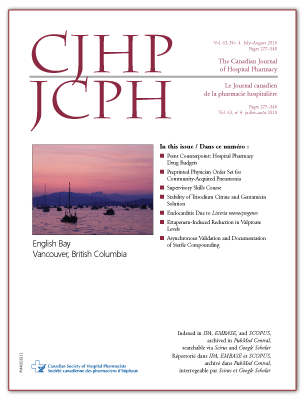Stability of Trisodium Citrate and Gentamicin Solution for Catheter Locks after Storage in Plastic Syringes at Room Temperature
DOI:
https://doi.org/10.4212/cjhp.v63i4.934Keywords:
gentamicin, citrate, stability, catheter lock solution, hemodialysis, high-performance liquid chromatography, gentamicine, stabilité, solution pour verrou de cathéter, hémodialyse, chromatographie liquide haute performanceAbstract
ABSTRACT
Background: Catheter-related infections are a major problem for hemodialysis patients with central venous catheters for vascular access. Catheter lock solutions containing an anticoagulant are used to maintain the patency of the catheter between hemodialysis sessions. There is evidence that the use of lock solutions containing an antibiotic is associated with lower rates of infection but also that these solutions can kill microbes in colonized catheters and thus avoid the risks and costs associated with replacing the catheter.
Objective: This stability study was conducted to determine whether an extemporaneously prepared gentamicin-citrate catheter lock solution would retain its potency over time, thus allowing for advance preparation of the solution.
Methods: Catheter lock solutions containing gentamicin alone, citrate alone, and the combination of gentamicin and citrate were prepared aseptically and packaged in polyethylene syringes. The syringes were stored at room temperature. At timed intervals over 112 days, samples were withdrawn for analysis by means of validated high performance liquid chromatography.
Results: None of the 3 lock solutions showed any evidence of degradation during the 112-day observation period. In the formulation containing both gentamicin 2.5 mg/mL and sodium citrate 40 mg/mL (4%), there was no change in the concentration of either gentamicin (p = 0.34) or citrate (p = 0.55). Linear regression analysis of the concentration- time data for the combined formulation showed that 99.97% of the labelled amount of gentamicin and 101.30% of the labelled amount of citrate remained at day 112. The lower limit of the 95% confidence intervals indicated that more than 98.17% of the gentamicin and more than 99.57% of the citrate remained on day 112.
Conclusion: The results of this study will allow pharmacies to extemporaneously compound the combined gentamicin-citrate catheter lock solution in advance of use. The method described here will yield a stable product for use in clinical applications.
RÉSUMÉ
Contexte : Les infections liées aux cathéters sont un problème important chez les patients hémodialysés dont l'abord vasculaire est réalisé à l'aide de cathéters veineux centraux. On a recours à des solutions pour verrou de cathéter contenant un anticoagulant afin de maintenir la perméabilité du cathéter entre les séances d'hémodialyse. Des données montrent que des solutions pour verrou renfermant un antibiotique sont associées à des taux d'infections inférieurs et que ces solutions peuvent tuer les microbes colonisant les cathéters, ce qui permet donc d'éviter les risques et les coûts associés au remplacement des cathéters.
Objectif : Cette étude de stabilité a été menée pour déterminer si une solution extemporanée de gentamicine et de citrate pour verrou de cathéter pouvait conserver sa puissance dans le temps, ce qui permettrait ainsi de préparer la solution à l'avance.
Méthodes : Des solutions pour verrou de cathéter contenant de la gentamicine seule, du citrate seul et l'association gentamicine-citrate ont été préparées selon une méthode aseptique, puis conditionnées dans des seringues de polyéthylène. Les seringues ont été conservées à la température ambiante. À différents points dans le temps sur une période de 112 jours, des échantillons ont été prélevés à des fins d'analyse à l'aide d'une épreuve validée par chromatographie liquide haute performance.
Résultats : Aucune des trois solutions pour verrou n'a montré de signes de dégradation durant les 112 jours de la période d'observation. La préparation contenant la gentamicine à 2,5 mg/mL et le citrate de sodium à 40 mg/mL (4 %) n'a montré aucun changement dans la concentration de gentamicine (p = 0,34) et de citrate (p = 0,55). Une analyse de régression linéaire des concentrations en fonction du temps de la préparation associant la gentamicine et le citrate a révélé que cette préparation avait retenu 99,97 % de sa concentration initiale de gentamicine et 101,30 % de sa concentration initiale de citrate au jour 112. La limite inférieure de l'intervalle de confiance à 95% a également révélé que la préparation avait retenu plus de 98,17 % de la gentamicine et plus de 99,57 % du citrate au jour 112.
Conclusion : Les résultats de cette étude permettront aux pharmacies de préparer à l'avance la solution extemporanée pour verrou de catheter renfermant l'association gentamicine-citrate. La méthode décrite ici donnera un produit stable pour une utilisation dans des applications cliniques.
Downloads
Downloads
Issue
Section
License
Copyright © Canadian Society of Healthcare-Systems Pharmacy.
After publication of a manuscript in the CJHP, the authors of the manuscript must obtain written permission from the CSHP (publications@cshp.ca) before reproducing any text, figures, tables, or illustrations from the work in future works of their own. If a submitted manuscript is declined for publication in the CJHP, all said rights shall revert to the authors. Please note that any forms (e.g., preprinted orders and patient intake forms) used by a specific hospital or other health care facility and included as illustrative material with a manuscript are exempt from this copyright transfer. The CJHP will require a letter from the hospital or health care facility granting permission to publish the document(s).










